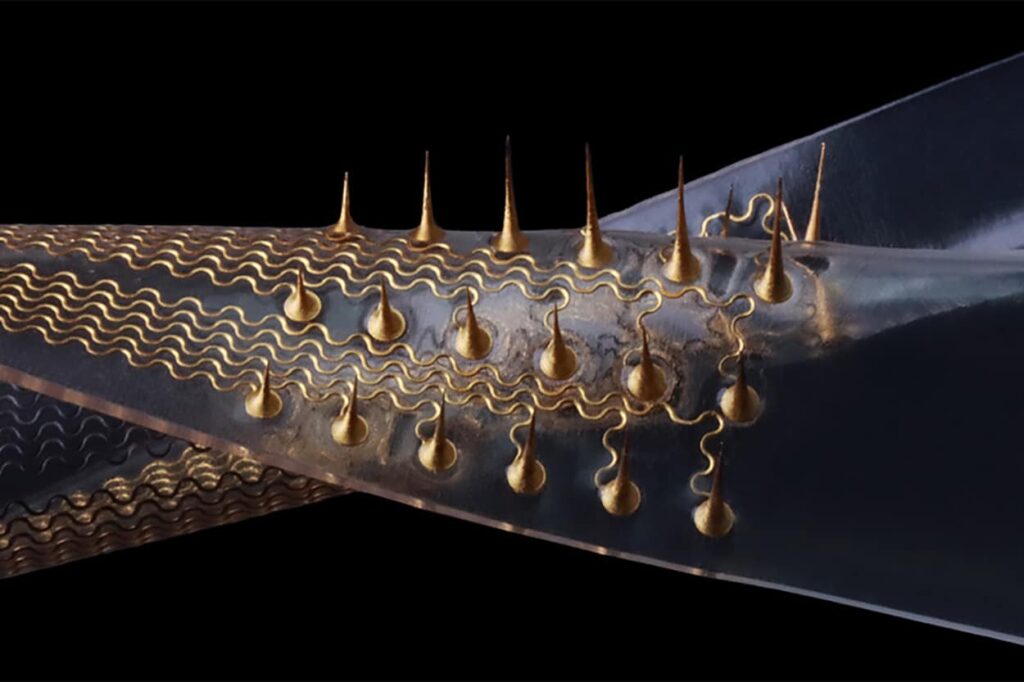Wearable bioelectronics, tissue engineering, neuroscience, and other fields could benefit from using stretchable three-dimensional (3D) penetrating microelectrode arrays. With their ability to penetrate and adapt to dynamically deforming tissues, these 3D microelectrode arrays provide minimally invasive targeted sensing and stimulation of interior regions. However, creating unique stretchable 3D microelectrode arrays requires difficulties with material integration and patterning.
In a new study, USC researcher Hangbo Zhao reported on developing “soft” and more flexible microneedles—essential for ensuring the comfort and high accuracy of long-term health tracking.
Zhao and his research group have developed a novel manufacturing process that produces stretchable three-dimensional penetrating microelectrode arrays.
Microneedle electrodes are extensively utilized in brain stimulation and sensing and in the identification of subcutaneous biomarkers. However, due to constraints in materials and fabrication techniques, nearly all microneedle electrodes now in use are stiff. Zhao, with his experience in advanced manufacturing, was able to conceive a more flexible solution.
The new “soft” microneedle electrodes are desirable for “deforming” or changing the contour of skin and muscle tissues. Zhao’s discovery opens the door for microneedle advancements that can sense ever-deeper into tissues and acquire more precise results. Electrodes must follow the target tissues’ deformations to ensure intimate contact and minimize tissue damage. High-fidelity sensing is becoming increasingly important, whether following minute variations in heartbeats or monitoring the workings of a weak bladder.
The invention is critical to developing a hybrid fabrication technique at Zhao’s USC lab. Microfabrication, transfer printing, and laser micromachining are combined in this low-cost, scalable process to create microneedle electrode arrays with the highest stretchability (60-90%) recorded.
Most importantly, the innovative fabrication process allows for easy customization of essential device features, including electrode shape, recording locations, and mechanical and electrical characteristics. Zhao’s research is organized around accuracy and adaptability, and his viewpoints on robotics and soft electronics also influence the flexible fabrication process.
Deep-sea origins are another fascinating aspect of the inquiry. The first demonstration of the viability of the globally applicable microneedle electrodes was the recording of electrical activity within the moving muscles of a sea slug.
Zhao and his research team immediately saw how the discoveries may be used for broader global biomedical applications. This platform technology can be applied to detect neuromuscular illnesses, transport drugs into deep tissues, sensing and regulating brain and nerve processes, and electrochemical sensing of skin interstitial fluids.
The next generation of extremely flexible “soft” microneedles may be the solution for people who fear them. For biotech businesses, healthcare experts, and anybody else looking to live a longer, healthier life, Zhao’s discovery represents a significant milestone in the ongoing pursuit of ever-more-accurate tracking to detect irregularities and identify prompt treatment.
Journal Reference:
Qinai Zhao, Ekaterina Gribkova, Yiyang Shen et al. Highly stretchable and customizable microneedle electrode arrays for intramuscular electromyography. Science Advances. DOI: 10.1126/sciadv.adn7202
>>> Read full article>>>
Copyright for syndicated content belongs to the linked Source : Tech Explorist – https://www.techexplorist.com/research-paves-way-flexible-soft-microneedles/84220/#utm_source=rss&utm_medium=rss&utm_campaign=research-paves-way-flexible-soft-microneedles
